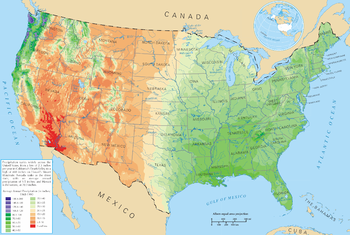Climate[edit]
Main article: Climate of the United States
Due to its large size and wide range of geographic features, the United States contains examples of nearly every global climate. The climate is temperate in most areas, subtropical in the Southern United States, tropical in Hawaii and southern Florida, polar in Alaska, semiarid in the Great Plains west of the 100th meridian, Mediterranean in coastal California and arid in the Great Basin. Its comparatively favorable agricultural climate contributed (in part) to the country's rise as a world power, with infrequent severe drought in the major agricultural regions, a general lack of widespread flooding, and a mainly temperate climate that receives adequate precipitation.
The main influence on U.S. weather is the polar jet stream which migrates northward into Canada in the summer months, and then southward into the USA in the winter months. The jet stream brings in large low pressure systems from the northern Pacific Ocean that enter the US mainland over the Pacific Northwest. The Cascade Range, Sierra Nevada, and Rocky Mountains pick up most of the moisture from these systems as they move eastward. Greatly diminished by the time they reach the High Plains, much of the moisture has been sapped by the orographic effect as it is forced over several mountain ranges.
Once it moves over the Great Plains, uninterrupted flat land allows it to reorganize and can lead to major clashes of air masses. In addition, moisture from the Gulf of Mexico is often drawn northward. When combined with a powerful jet stream, this can lead to violent thunderstorms, especially during spring and summer. Sometimes during winter these storms can combine with another low pressure system as they move up the East Coast and into the Atlantic Ocean, where they intensify rapidly. These storms are known as Nor'easters and often bring widespread, heavy snowfall to New England. The uninterrupted flat grasslands of the Great Plains also lead to some of the most extreme climate swings in the world. Temperatures can rise or drop rapidly and winds can be extreme, and the flow of heat waves or Arctic air masses often advance uninterrupted through the plains.
The Great Basin and Columbia Plateau (the Intermontane Plateaus) are arid or semiarid regions that lie in the rain shadow of the Cascades and Sierra Nevada. Precipitation averages less than 15 inches (38 cm). The Southwest is a hot desert, with temperatures exceeding 100 °F (37.8 °C) for several weeks at a time in summer. The Southwest and the Great Basin are also affected by the monsoon from the Gulf of California from July to September, which brings localized but often severe thunderstorms to the region.
Much of California consists of a Mediterranean climate, with sometimes excessive rainfall from October–April and nearly no rain the rest of the year. In the Pacific Northwest rain falls year-round, but is much heavier during winter and spring. The mountains of the west receive abundant precipitation and very heavy snowfall. The Cascades are one of the snowiest places in the world, with some places averaging over 600 inches (1,524 cm) of snow annually, but the lower elevations closer to the coast receive very little snow.
Florida has a subtropical climate in the northern and central part of the state and a tropical climate in the far southern part of the state. Summers and wet and winters are dry in Florida. Annually much of central and southern Florida are frost-free. The mild winters of Florida allow a massive citrus industry to thrive in the central part of the state, and Florida is second to only Brazil in citrus production in the world.
Another significant (but localized) weather effect is lake-effect snow that falls south and east of the Great Lakes, especially in the hilly portions of the Upper Peninsula of Michigan and on the Tug Hill Plateau in New York. The lake effect dumped well over 5 feet (1.52 m) of snow in the area of Buffalo, New York throughout the 2006-2007 winter. The Wasatch Front and Wasatch Range in Utah can also receive significant lake effect accumulations from the Great Salt Lake.


No comments:
Post a Comment